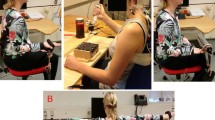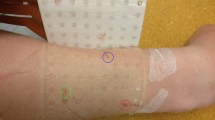Abstract
The aim of this work is to show how changes in surface electromyographic activity (sEMG) during a repetitive, non-constant force contraction can be detected and interpreted on the basis of the amplitude distribution provided by high-density sEMG techniques. Twelve healthy male subjects performed isometric shoulder elevations, repeating five times a force ramp profile up to 25 % of the maximal voluntary contraction (MVC). A 64-electrode matrix was used to detect sEMG from the trapezius muscle. The sEMG amplitude distribution was obtained for the force levels in the range 5–25 % MVC with steps of 5 % MVC. The effect of force level, subject, electrode position and ramp repetition on the sEMG amplitude distribution was tested. The sEMG amplitude was significantly smaller in the columns of the electrode grid over the tendons (repeated measures ANOVA, p < 0.01). The barycentre of the distribution of sEMG amplitude was subject-specific (Kruskal–Wallis test, p < 0.01), and shifted caudally with the increase of force levels and cranially with the repetition of the motor task (both p < 0.01, repeated measures ANOVA). The results are discussed in terms of motor unit recruitment in different muscle sub-portions. It is concluded that the sEMG amplitude distribution obtained by multichannel techniques provides useful information in the study of muscle activity, and that changes in the spatial distribution of the recruited motor units during a force varying isometric contraction might partially explain the variability observed in the activation pattern of the upper trapezius muscle.





Similar content being viewed by others
Abbreviations
- EMG:
-
Electromyography
- sEMG:
-
Surface electromyography
- MU:
-
Motor unit
- MVC:
-
Maximal voluntary contraction
- IZ:
-
Innervation zone
- RMS:
-
Root mean square
- ANOVA:
-
Analysis of variance
References
Balogh I, Hansson GA, Ohlsson K, Strömberg U, Skerfving S (1999) Interindividual variation of physical load in a work task. Scand J Work Environ Health 25(1):57–66
Barbero M, Gatti R, Lo Conte L, Macmillan F, Coutts F, Merletti R (2011) Reliability of surface EMG matrix in locating the innervation zone of the upper trapezius. J Electromyogr Kinesiol 21(5):827–833
Desmedt JE, Godaux E (1981) Spinal motoneuron recruitment in man: rank deordering with direction but not with speed of voluntary movement. Science 214(4523):933–936
English AW, Segal RL (1993) Compartmentalization of muscles and their motor nuclei: the partitioning hypothesis. Phys Therapy 73(12):857–867
Falla D, Farina D (2008a) Motor units in cranial and caudal regions of the upper trapezius muscle have different discharge rates during brief static contractions. Acta Physiol (Oxf) 192(4):551–558
Falla D, Farina D (2008b) Non-uniform adaptation of motor unit discharge rates during sustained static contraction of the upper trapezius muscle. Exp Brain Res 191(3):363–370
Farina D, Leclerc F, Arendt-Nielsen L, Buttelli O, Pascal M (2008) The change in spatial distribution in upper trapezius muscle activity is correlated to contraction duration. J Electromyogr Kinesiol 18:16–25
Fjellman-Wiklund A, Grip H, Karlsson JS, Sundelin G (2004) EMG trapezius muscle activity pattern in string players: part I—is there variability in the playing technique? Int J Ind Ergon 33:347–356
Fujii S, Kudo K, Ohtsuki T, Oda S (2009) Tapping performance and underlying wrist muscle activity of non-drummers, drummers, and the world’s fastest drummer. Neurosci Lett 459(2):69–73
Furuya S, Kinoshita H (2008) Organization of the upper limb movement for piano key-depression differs between expert pianists and novice players. Exp Brain Res 185:581–593
Holtermann A, Roeleveld K, Karlsson JS (2005) Inhomogeneities in muscle activation reveal motor unit recruitment. J Electromyogr Kinesiol 15:131–137
Holtermann A, Karlsson JS, Roeleveld K (2008) Spatial distribution of active muscle fibre characteristics in the upper trapezius muscle and its dependency on contraction level and duration. J Electromyogr Kinesiol 18(1):16–25
Holtermann A, Roeleveld K, Mork PJ et al (2009) Selective activation of neuromuscular compartments within the human trapezius muscle. J Electromyogr Kinesiol 19:896–902
Holtermann A, Roeleveld K (2006) EMG amplitude distribution changes over the upper trapezius muscle are similar in sustained and ramp contractions. Acta Physiol 186:159–168
Johnson G, Bogduk N, Nowitze A, House D (1994) Anatomy and actions of the trapezius muscle. Clin Biomech 9(1):44–50
Kleine B, Schumann N, Stegeman DF (2000) Surface EMG mapping of the human trapezius muscle: the topography of monopolar and bipolar surface EMG amplitude and spectrum parameters at varied forces and in fatigue. Clin Neurophysiol 111:686–693
Madeleine P, Leclerc L, Arendt-Nielsen L, Ravier P, Farina D (2006) Experimental muscle pain changes the spatial distribution of upper trapezius muscle activity during sustained contraction. Clin Neurophysiol 117:2436–2445
Mathiassen SE, Aminoff T (1997) Motor control and cardiovascular responses during isoelectric contractions of the upper trapezius muscle: evidence for individual adaptation strategies. Eur J Appl Physiol Occup Physiol 76(5):434–444
Merletti R, Rainoldi A, Farina D (2001) Surface electromyography for noninvasive characterization of muscle. Exerc Sport Sci Rev 29:20–25
Merletti R, Botter A, Cescon C, Minetto MA, Vieira TM (2010) Advances in surface EMG: recent progress in clinical research applications. Crit Rev Biomed Eng 38(4):347–379
Mork PJ, Westgaard RH (2005) Long-term electromyographic activity in upper trapezius and low back muscles of women with moderate physical. J Appl Physiol 99:570–578
Osu R, Franklin DW, Kato H et al (2002) Short- and long-term changes in joint co-contraction associated with motor learning as revealed from surface EMG. J Neurophysiol 88:991–1004
Palmerud G, Sporron H, Herberts P, Kadefors R (1998) Consequences of trapezius relaxation on the distribution of shoulder muscle forces: an electromyographic study. J Electromyogr Kinesiol 8(3):185–193
Troiano A, Naddeo F, Sosso E, Camarota G, Merletti R, Mesin L (2008) Assessment of force and fatigue in isometric contractions of the upper trapezius muscle by surface EMG signal and perceived exertion scale. Gait Posture 28:179–186
Tucker K, Butler J, Graven-Nielsen T, Riek S, Hodges P (2009) Motor unit recruitment strategies are altered during deep-tissue pain. J Neurosci 29:10820–10826
Staudenmann D, Kingma I, Daffertshofer A, Stegeman DF, Van Dieen JH (2009) Heterogeneity of muscle activation in relation to force direction: a multi-channel surface electromyography study on the triceps surae muscle. J Electromyogr Kinesiol 19:882–895
Vieira TMM, Loram I, Muceli S, Merletti R, Farina D (2011) Postural activation of the human medialis gastrocnemius muscle: are the muscle units spatially localised? J Physiol 589(2):431–443
Watanabe K, Kouzaki M, Moritani T (2011) Task-dependent spatial distribution of neural activation pattern in human rectus femoris muscle. J Electromyogr Kinesiol 22(2):251–258
Wickham JB, Brown JM (2012) The function of neuromuscular compartments in human shoulder muscles. J Neurophysiol 107(1):336–345
Zhou P, Suresh NL, Rymer WZ (2011) Surface electromyogram analysis of the direction of isometric torque generation by the first dorsal interosseous muscle. J Neural Eng 8(3):036028
Acknowledgments
This work was financially supported by Fondazione Cassa di Risparmio di Torino, Italy, and Compagnia di San Paolo, Torino, Italy.
Conflict of interest
The authors declare that they have no conflict of interest.
Author information
Authors and Affiliations
Corresponding author
Additional information
Communicated by Toshio Moritani.
Rights and permissions
About this article
Cite this article
Gallina, A., Merletti, R. & Gazzoni, M. Uneven spatial distribution of surface EMG: what does it mean?. Eur J Appl Physiol 113, 887–894 (2013). https://doi.org/10.1007/s00421-012-2498-2
Received:
Accepted:
Published:
Issue Date:
DOI: https://doi.org/10.1007/s00421-012-2498-2




